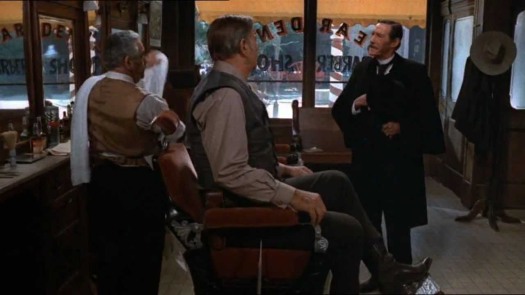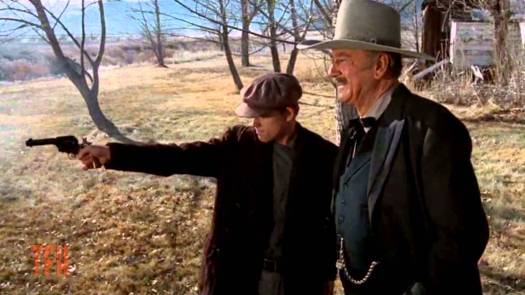THE SHOOTIST is John Wayne’s valedictory statement, a final love letter to his many fans. The Duke was now 69 years old and not in the best of health. He’d had a cancerous lung removed back in 1964, and though the cancer was in remission, Wayne must’ve knew his days were numbered when he made this film. Three years later, he died from cancer of the stomach, intestines, and spine. There were worries about his ability to make this movie, but Wayne loved the script and was determined to do it. The result is an elegy to not only the aging actor, but to the Western genre as a whole.
The movie begins with footage of older Wayne westerns (EL DORADO, HONDO, RED RIVER, RIO BRAVO) narrated by Ron Howard (Gillom). “His name was J.B. Books…he wasn’t an outlaw. Fact is, for a while he was a lawman…He had a credo that went, ‘I won’t be wronged. I won’t be insulted. I won’t be laid a hand on. I don’t do these things to other people, and I require the same from them’ “. Books arrives in Carson City, Nevada in the year 1901, a thriving city in a changing world. He’s come to visit his old friend Doc Hostetler (James Stewart), and get a second opinion. Hostetler examines him and gives Books the bad news, ” You have a cancer…advanced”. The doctor can’t do anything to help his friend, except give him Laudanum for the pain. Describing how the end will come, Hostetler says, “I don’t think the death I just described to you is the one I would choose”.
Books decides to spend his last days in Carson City, taking a room with widowed Bond Rogers (Lauren Bacall) and her restless son Gillom. The young man idolizes Books when he finds out his identity, treating him like rock-star royalty. Others in the town aren’t so welcoming, including Marshal Thibido (Harry Morgan) and Mike Sweeney (Richard Boone), an ornery cuss whose brother was killed by Books. News of the celebrity in Carson City spreads, with faro dealer Jack Pulford (Hugh O’Brien) and local tough guy Jay Cobb (Bill McKinney) wondering how they would fare against the dying gunfighter.
Others seek to cash in on Books’ pending demise. Newspaperman Dobkins (Rick Lenz) wants to write up a series of articles on Books’ colorful career, only to receive a gun in the mouth and a boot in the ass for his nerve. Former flame Serepta (Sheree North) wants to marry him and trade in on his name. Undertaker Hezekiah Beckum (John Carradine in a wonderful cameo) offers a free funeral, hoping to put Books’ body on display, but ends up paying Books. The doomed Books, who only seeks to die with dignity and honor, devises a plan once the pain becomes too great to bear. He has Gillom invite Pulford, Sweeney, and Cobb to join him Monday morning for a last stand that’s tensely staged… and comes with a surprise twist.
Don Siegel directed THE SHOOTIST with his usual style, handling the well-stocked cast of veterans. Bacall, Boone, Carradine, and Stewart had all costarred with The Duke in films past, making this a sort of last round-up for them all. Bacall is particularly good as the widow Rogers, who despises Books at first until she learns he’s dying of cancer (Bacall’s first husband, the great Humphrey Bogart, died of the disease). Then her Christian charity shines through, and though she disapproves of his former lifestyle, the two gain a mutual respect. Ron Howard has what’s probably his best film role here, a long way from Opie in THE ANDY GRIFFITH SHOW and Richie in HAPPY DAYS. The superstar director of today gives a terrific performance, having honed his acting chops by working with so many legendary actors and directors in his career. Gillom is a young wastrel with no solid direction in his life until he meets Books. His involvement in the final shootout scene evokes strong emotions in anyone who watches this film.
The screenplay by Miles Hood Swarthout and Scott Hale is full of memorable dialogue. I love the use of language in this film, it has a poetic quality to it that separates it from the usual Wayne Western. The actors all deliver their lines with conviction, and it’s no surprise considering that marvelous cast. Besides those I’ve mentioned, Scatman Crothers also shines in his small role. But it’s John Wayne who dominates the show. The Duke may move a little slower, and his voice may be ravaged by time and illness, but he’s still The Duke. The cancer that eventually killed him hadn’t been detected yet, but somewhere in the back of his mind I’m sure Wayne knew THE SHOOTIST would be his last cinematic stand. His final public appearance was at the 1979 Academy Awards:
(One trivia note: Charles G. Martin plays the man who guns down Wayne. The Duke also bit the dust onscreen in only six other films. Can you name them?)







Biting dust.
True Grit! I can’t remember the names of the rest.
LikeLiked by 1 person
Wayne was gunned down in “The Cowboys”. I seen “The Shootist” I know he was gunned down in it. I don’t remember the others.
LikeLiked by 1 person
Yes! The cowboys! Loved the movie!
LikeLiked by 2 people
I did too, even with tears of Wayne dying in the movie, lol.
LikeLiked by 2 people
LOL! Me too!
LikeLiked by 2 people
Real hard sadness scene brings out the blabber in me, lol.
LikeLiked by 2 people
LOL!
LikeLiked by 2 people
LikeLiked by 2 people
The ending was good where the boys become men.
LikeLiked by 2 people
Yrs, they were taught well!
LikeLiked by 2 people
Amen
LikeLiked by 2 people
LikeLiked by 2 people
:). Love John Wayne.
LikeLiked by 2 people
🙂
LikeLiked by 1 person
So far, you’ve got one…”The Cowboys”. Anyone else want to take a shot? (Hint: They’re not all Westerns!)
LikeLiked by 1 person
I know he died on most of the movies but I can’t remember the name of it! Only thing I remember is the western!
LikeLiked by 1 person
here’s one, The Sands of Iwo Jima
LikeLiked by 1 person
Yep! That’s two, four to go!
LikeLike
Hey, I know another one ‘The Alamo’, nobody survived that one, except maybe that old guy from F-Troop
LikeLiked by 1 person
LOL Bob Steele….and you’re right!
LikeLike
LikeLiked by 1 person
I agree with you about the dialog in this movie. That’s one of the reasons I love this movie and “True Grit” One of the things I didn’t like about the remake of “True Grit” is that there was no poetry to the way the characters spoke. In fact, most dialog in movies made nowadays is dull, bland and sounds like people are talking AT each other and not TO each other.
This is probably the best movie role that Ron Howard had. He wasn’t able to make the transition from child actor to adult actor as he never really was convincing in most of the the adult roles he played. He’s doing better as a director, I think. Great review.
LikeLike
Yes, the language used in The Shootist contributes greatly to the film as a whole. I agree that today’s movies just don’t have as strong a writing quality as the older ones. It’s definitely Howard’s best adult role, and he made a smart decision to go into directing.Thanks again!
LikeLike
This post was quite moving. It’s true what you say, all of it, being a farewell to Wayne and Westerns. Great performances and, like you said, a wonderful script.
LikeLiked by 1 person
Thank you. The Duke has always been my favorite classic star, and I wanted to give him a worthy tribute. I’m glad you liked it.
LikeLike
Sometimes I think The Duke is too easily dismissed. He made everything look so darn easy. For example, in “Trouble Along the Way”, there is a scene in a pool hall where he gives a monologue about his life philosophy. He does this while lining up his shots on a pool table, and MAKING those shots. Shot after shot, he sinks the balls while acting and remembering a sold page of dialogue. I’ve seen him do that in other movies, too.
LikeLiked by 1 person
Yes, that ease of being throws a lot of people off. The fact is, Wayne was a good actor. His Rooster Cogburn is nothing like Ethan Edwards in The Searchers, or Sgt. Striker in Sands of Iwo Jima. Sure, many of his later films were “star vehicles” and formulaic, but much of his work gets unfairly dismissed.
LikeLiked by 1 person
“Reap the Wild Wind” (1942) death by squid; “The Fighting Seabees” (1944) death by sniper; “The Sands of Iwo Jima” (1949) death by sniper; “Wake of the Red Witch” (1949) death by drowning/sinking ship; “The Alamo” (1960) killed by Mexican soldier; “The Cowboys” (1972) shot by Bruce Dern; “The Shootist” (1976) killed by the bartender with a shotgun.
LikeLiked by 1 person